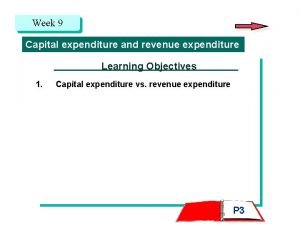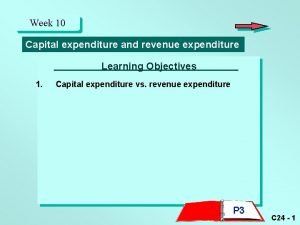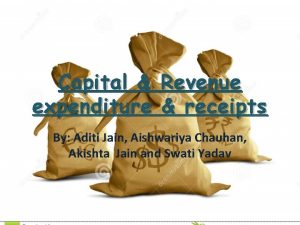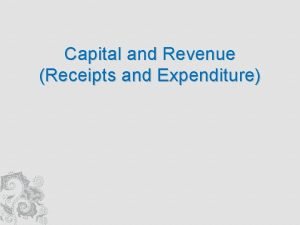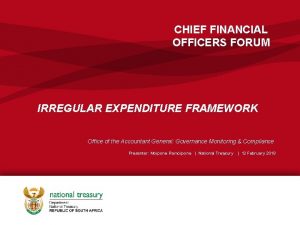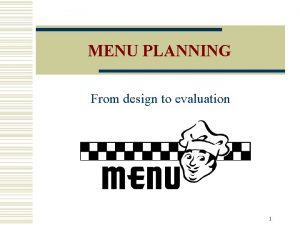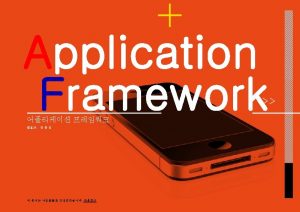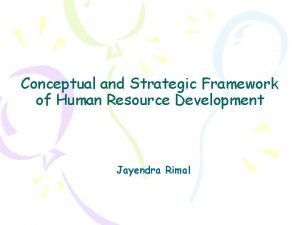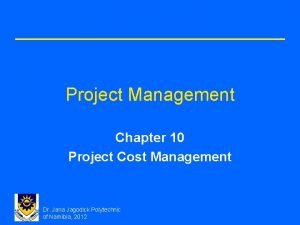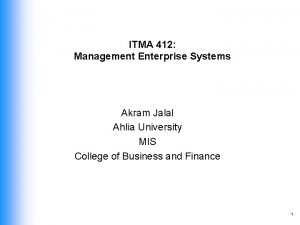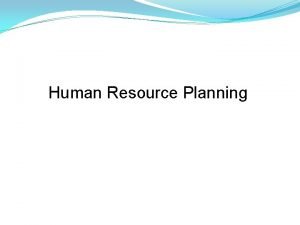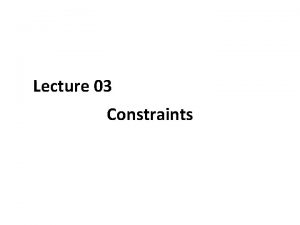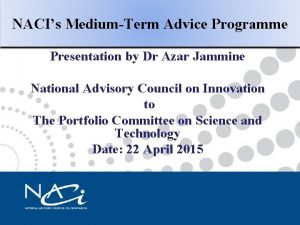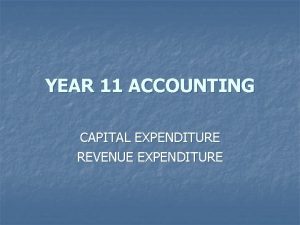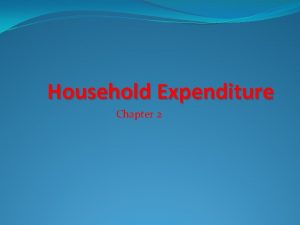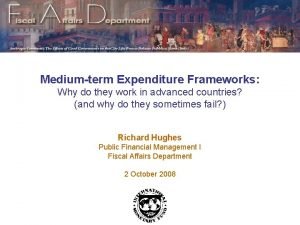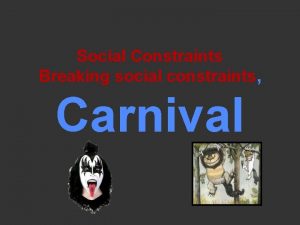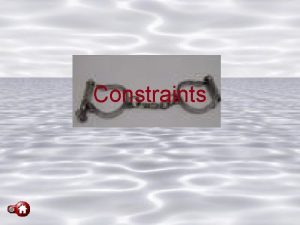MediumTerm Expenditure Framework Planning under resource constraints The















- Slides: 15

Medium-Term Expenditure Framework Planning under resource constraints The World Bank Bill Dorotinsky Public Sector Group PE Perspectives for HD November 12, 2003

Outline • Introduction to MTEF – Core questions for Government – Common PEM problems – What is an MTEF? – Technical Objectives • Five stages of MTEF • Changing roles and responsibilities The World Bank

Core Questions for Government • • • Are national objectives being met? Are sector objectives met? Policies implemented? Do resources flow to programs as planned? Is budget used as tool for steering and managing government? Does Government get the information and analysis it needs to make good choices? • Does the budget process support good decision-making? Effective programs? • Are potential spending or policy crises anticipated and managed (versus reacted to after they become a crisis)? • Is spending efficient and effective? If you answered “no” to some of these, then perhaps there is a need to think differently…. . The World Bank

Common PEM problems • Weak links between policy, resource limits, and budgets – failure to achieve strategic objectives – abstract planning, unrelated to ways and means – resources do not flow to line agencies • Annual focus leads to suboptimal choices – Digging a hole: complacency today, unaware of crisis tomorrow – Inability to climb out of poor fiscal situation • Separation between capital and recurrent budgets – Lower than expected returns to capital • Non-comprehensive budget – Using other means to support favored programs • Failure to think strategically about tools and objectives • Not learning from experience • Not harnessing energies of all actors in system; mismatch of roles and responsibilities • Taking piecemeal decisions without reference to over-all effect The World Bank

Three Objectives of Public Expenditure Management Systems • Macrofiscal discipline and stability – Avoid public finance crises – Support economic growth and stability • Strategic allocation of resources – Match government policy with programs, objectives – Assure resources flow to programs, aligned with budget priorities • Technical efficiency – Getting the most from each zloty spent – Improving service delivery The World Bank

What is an MTEF about? • Process, not only components, of public expenditure systems – – process of government decision-making developing a “public interest” in decision-makers Multi-year emphasis creating a learning system • Emphasizing policy – steering versus rowing for senior officials, organizations – linking policy, inputs, outputs, objectives • Effort to change paradigm, incentives of actors in system The World Bank

Technical Objectives of MTEF • Improve macrofiscal situation – lower deficits, improved economic growth – more rational approach to retrenchment and economic stabilization • Improve impact of Government policy – link between government priorities/policies and government programs • Improve program performance/impact – Shift bureaucracy from administrative to managerial culture • Managerial flexibility & innovation: lower cost/output; greater effectiveness of programs/policies • More efficient use of resources – Improved resource predictability to line agencies The World Bank

MTEF: New Budget Process • Stage 1. Macroeconomic and public sector envelopes • Stage 2. High-level policy: aligning policies & objectives under resource constraints • Stage 3. Linking policy, resources, and means by sector • Stage 4. Reconciling resources with means • Stage 5. Reconciling strategic policy and means The World Bank

Stage 1. Macroeconomic and public sector envelopes Macroeconomic Estimates Revenue Estimates Fiscal Policy Expenditure Estimates (current services) Expenditure Estimates (current law, normatives) All in multi-year context The World Bank • Affordable/sustainable Fiscal Envelope • Monetary and Fiscal Policy • Debt and Deficits • Aid flows

Stage 2. High-level policy: aligning policies & objectives under constraints Fiscal Envelope Sectoral Resource Ceilings Setting Strategic Policy Priorities Under Resource Limits (downsizing, or expansions) The World Bank Ministry Resource Ceilings • Comprehensive resource plans

Stage 3. Linking policy, resources, and means by sector Sector Policies and Objectives Reconcile policy, laws, resource limits Multi-year strategy Program priorities relative to objectives Sector programs Assess modalities for objective Evaluate Production Function; Identify Cost Drivers Sector Budget Request Again, multi-year The World Bank Under ceiling Above ceiling

Stage 4. Reconciling resources with means Sector Ceilings Sector Requests Technical Assessment and Reconciliatio n Vetting assumptions, policies, estimates Challenging modalities, production function Evaluate performance Revised requests and/or decision papers The World Bank

Stage 5. Reconciling strategic policy and means Policy assessment and reconciliation Revised Requests, Unresolved Issues The World Bank Policy official dialogue Modify baselines Finalize decisions Budget Proposal

Roles and responsibilities before… • Issues broad guidance at start of process, with cost increase assumptions Ministry of Finance • Cutting spending requests uniformly or by economic class or line item to meet totals • Heavy involvement in setting line item totals • No idea of out-year implications of choices • Develop requests in vacuum • Request is wish list; incentive to ask for more, hoping that after cuts will have enough Line Ministry • Little discretion to allocate funds in own budget • Little incentive to focus on current programs, reallocate • Minimal policy content in budget request The World Bank • Low likelihood of getting budget levels during year

…. And after • Issues broad guidance with multi-year sector ceilings at start of process (cabinet approved) Ministry of Finance • Cuts spending requests only if above ceiling • Little involvement in setting line item totals, except perhaps capital and personnel • Clearer picture of future implications of current choices • Clear resource framework for planning • Request must prioritize between current and new programs Line Ministry • Near complete discretion to allocate funds in own budget • Potential for larger policy content in budget request The World Bank • Ceterus paribus, higher likelihood of receiving budget levels during year
 Capital and revenue expenditure
Capital and revenue expenditure Capital and revenue expenditure
Capital and revenue expenditure Meaning of revenue expenditure
Meaning of revenue expenditure Receipts and expenditure meaning
Receipts and expenditure meaning I blew it 14 million moipone
I blew it 14 million moipone Menu planning constraints
Menu planning constraints Resource allocation vs resource leveling
Resource allocation vs resource leveling Perbedaan resource loading dan resource leveling
Perbedaan resource loading dan resource leveling Human resource development framework
Human resource development framework Resource manager in android framework
Resource manager in android framework Strategic framework of hrd
Strategic framework of hrd Zero base forecasting
Zero base forecasting Resource aggregation in project management
Resource aggregation in project management Enterprise resource planning example
Enterprise resource planning example Short term human resources examples
Short term human resources examples Resource management responsibilities
Resource management responsibilities
